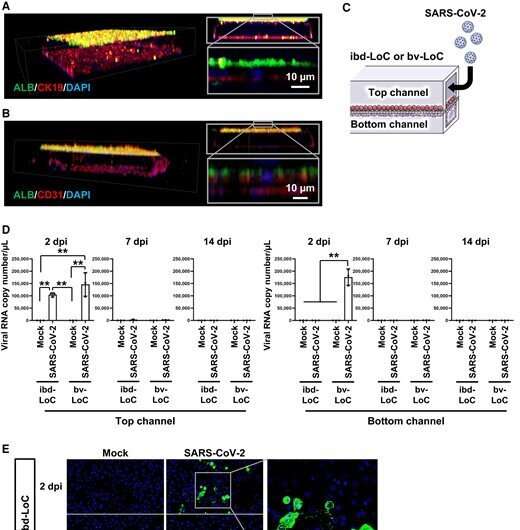This article has been reviewed according to Science X's editorial process and policies. Editors have highlighted the following attributes while ensuring the content's credibility:
fact-checked
peer-reviewed publication
trusted source
proofread
Using organ-on-a-chip technology to elucidate the liver pathophysiology of COVID-19 patients

SARS-CoV-2 infects and causes damage to multiple organs in COVID-19 patients. In particular, liver damage has been associated with COVID-19 severity. However, an understanding of the liver pathophysiology of these patients remains largely incomplete.
To investigate this pathophysiology, the group developed liver models that mimic the liver around blood vessels or bile ducts using organ-on-a-chip technology. Human hepatocytes and cholangiocytes (bile duct epithelial cells) were cultured in the top and bottom channels of microfluidic devices, respectively, to create the liver-on-a-chip with intrahepatic bile duct (ibd-LoC). Similarly, human hepatocytes and vascular endothelial cells were cultured in adjacent channels of microfluidic devices to produce the liver-on-a-chip with a blood vessel (bv-LoC).
The researchers infected these LoCs with SARS-CoV-2 to model the liver pathophysiology of COVID-19 patients and detected the virus in both ibd-LoCs and bv-LoCs two days following infection. Interestingly, despite observing viral clearance after two weeks, increased hepatotoxicity and lipid droplet accumulation continued in the infected bv-LoCs, but not in the infected ibd-LoCs.
These findings suggest that the vascularized parts of the liver are more vulnerable to damage by SARS-CoV-2 infection, and such damage is responsible for the liver dysfunctions experienced by COVID-19 patients.
In addition, the team screened for therapeutic drugs that can treat these liver abnormalities and found the combined treatment of remdesivir and baricitinib to significantly reduce the hepatotoxicity and lipid droplet accumulation observed in the infected bv-LoCs, suggesting that these two drugs could be effective to treat liver injuries caused by SARS-CoV-2 infection.
Organ-on-a-chip technologies, such as the ones described in this study, will help to broaden the understanding of organ dysfunctions in COVID-19 patients and accelerate the development of therapeutic agents to treat this catastrophic disease.
The results of this research were published online in PNAS Nexus on March 7, 2023.
More information: Sayaka Deguchi et al, Elucidation of the liver pathophysiology of COVID-19 patients using liver-on-a-chips, PNAS Nexus (2023). DOI: 10.1093/pnasnexus/pgad029



















